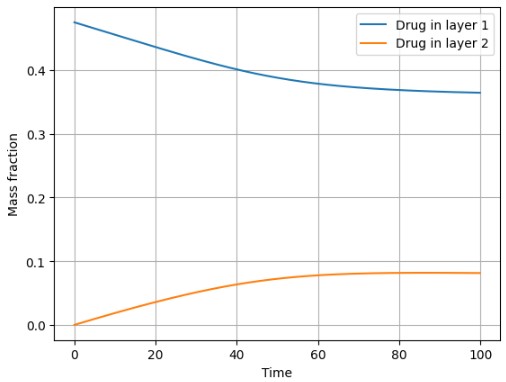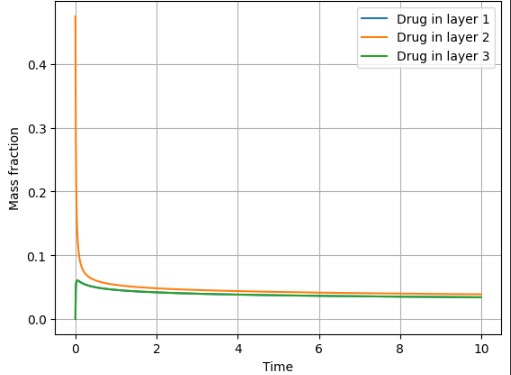Formulation and Delivery - Chemical
(T1430-06-38) A Computational Approach for Studying Drug Delivery Process Through Multilayered Drug Delivery Devices
Tuesday, November 11, 2025
2:30 PM - 3:30 PM CT

Prateek K. Jha, Ph.D. (he/him/his)
Professor
IIT Roorkee
Roorkee, Uttarakhand, India- PP
Pratyush Pandey, B.Tech.
Masters Student
IIT Roorkee
Roorkee, Uttarakhand, India
Presenting Author(s)
Main Author(s)
Purpose: Multilayered drug delivery systems provide several advantages over conventional drug delivery systems, such as avoidance of burst release, multiple administrations are not required because of the sustained drug release, also the presence of multiple layers provides the API with both mechanical and chemical protection from the outside environment. In order to design a drug delivery system both in vitro and in vivo experiments are required which are expensive both in terms of time and money. We have designed and developed a model that provides us with a qualitative idea of the resulting drug release profiles which will help in the design of multilayered drug delivery systems by effectively reducing the resources required both in terms of time and money.
Methods: We have used the finite difference method to develop a model for an n-layered drug delivery device. For the drug delivery process, the drug diffusion outwards, the outer media fluid diffusion inside the device, which causes the swelling phenomena, and also surface erosion, have been taken into account. We have considered two types of systems, in the first one drug is in the first layer only and there are subsequent layers of polymer above it, also below the first layer is a impermeable membrane which avoids the drug release from this side, this kind of system applies to transdermal patches or films that are applied on the specific organs to deliver a drug. In the second system, the drug is in the middle layer only, and there are subsequent layers of polymer above and below it, this kind of system applies to a cylindrical tablet whose thickness is significantly less as compared to the radius which results in significantly less radial diffusion of drug as compared to the axial diffusion. The schematic of these systems is provided in the images section.
Results: The drug release profiles in system type-1 are showing the same trends as expected, that is, in the case of two layers, the concentration in layer 1 is decreasing continuously, and the concentration in layer 2 is first increasing because of the flux from the first layer and then decreasing because it’s ultimately diffusing outwards. In case of system type-2 the drug release profiles are also showing the expected results, i.e. in case of 3 layers drug being in the middle one, the concentration is continuously decreasing in the middle layer as the drug is diffusing outwards to both the bottom and top layer, and in top and bottom layer the mass fraction is first increasing because of influx from the bottom layer and then decreasing continuously as drug is going to diffuse outwards. The effect of varying thickness ratios of subsequent layers keeping the total length fixed, effect of varying diffusivity of the subsequent layers, and the effect of number of layer is also studied.
Conclusion: This model offers a qualitative idea regarding the effect of diffusivity, length, and number of layers on the drug release profiles. This will help the researchers developing the drug delivery systems to choose the parameters such as diffusivity which will depend on the polymer blend, thickness ratio, and the number of layers, and also the drug and polymer amount effectively in accordance with the disease they are trying to treat which will also relate to how long they want the sustained drug release. This model finds usefulness particularly in designing the multilayer drug delivery systems of rectangular geometry such as transdermal patches, films and rectangular tablets (or even cylindrical ones with dominant axial diffusion). Although we acknowledge that this model is a simplistic one and uses assumptions such as linear concentration profiles within the layers (to increase the accuracy of this model we can anyways increase the number of nodes) and there will be slight deviation in predicting and the exact concentrations of drug, but it is challenging to predict the precise drug concentration anyway as many variables(such as diffusivity of the polymer blend we get from fitting the curves) and complex phenomena are involved. So having a qualitative idea about effects of various important parameters such as length diffusivity and number of layers will have a significant impact in reducing the time and cost involved in performing various in vitro and in vivo experiments.
Acknowledgements: The authors thank the financial support of Anusandhan National Research Foundation, India, project number CRG/2022/003774. The authors also gratefully acknowledge the facilities provided by the Indian Institute of Technology Roorkee.
.jpg)
Schematic of Model

Drug Release Profile for Case I

Drug Release Profile for Case II
Methods: We have used the finite difference method to develop a model for an n-layered drug delivery device. For the drug delivery process, the drug diffusion outwards, the outer media fluid diffusion inside the device, which causes the swelling phenomena, and also surface erosion, have been taken into account. We have considered two types of systems, in the first one drug is in the first layer only and there are subsequent layers of polymer above it, also below the first layer is a impermeable membrane which avoids the drug release from this side, this kind of system applies to transdermal patches or films that are applied on the specific organs to deliver a drug. In the second system, the drug is in the middle layer only, and there are subsequent layers of polymer above and below it, this kind of system applies to a cylindrical tablet whose thickness is significantly less as compared to the radius which results in significantly less radial diffusion of drug as compared to the axial diffusion. The schematic of these systems is provided in the images section.
Results: The drug release profiles in system type-1 are showing the same trends as expected, that is, in the case of two layers, the concentration in layer 1 is decreasing continuously, and the concentration in layer 2 is first increasing because of the flux from the first layer and then decreasing because it’s ultimately diffusing outwards. In case of system type-2 the drug release profiles are also showing the expected results, i.e. in case of 3 layers drug being in the middle one, the concentration is continuously decreasing in the middle layer as the drug is diffusing outwards to both the bottom and top layer, and in top and bottom layer the mass fraction is first increasing because of influx from the bottom layer and then decreasing continuously as drug is going to diffuse outwards. The effect of varying thickness ratios of subsequent layers keeping the total length fixed, effect of varying diffusivity of the subsequent layers, and the effect of number of layer is also studied.
Conclusion: This model offers a qualitative idea regarding the effect of diffusivity, length, and number of layers on the drug release profiles. This will help the researchers developing the drug delivery systems to choose the parameters such as diffusivity which will depend on the polymer blend, thickness ratio, and the number of layers, and also the drug and polymer amount effectively in accordance with the disease they are trying to treat which will also relate to how long they want the sustained drug release. This model finds usefulness particularly in designing the multilayer drug delivery systems of rectangular geometry such as transdermal patches, films and rectangular tablets (or even cylindrical ones with dominant axial diffusion). Although we acknowledge that this model is a simplistic one and uses assumptions such as linear concentration profiles within the layers (to increase the accuracy of this model we can anyways increase the number of nodes) and there will be slight deviation in predicting and the exact concentrations of drug, but it is challenging to predict the precise drug concentration anyway as many variables(such as diffusivity of the polymer blend we get from fitting the curves) and complex phenomena are involved. So having a qualitative idea about effects of various important parameters such as length diffusivity and number of layers will have a significant impact in reducing the time and cost involved in performing various in vitro and in vivo experiments.
Acknowledgements: The authors thank the financial support of Anusandhan National Research Foundation, India, project number CRG/2022/003774. The authors also gratefully acknowledge the facilities provided by the Indian Institute of Technology Roorkee.
.jpg)
Schematic of Model

Drug Release Profile for Case I

Drug Release Profile for Case II
